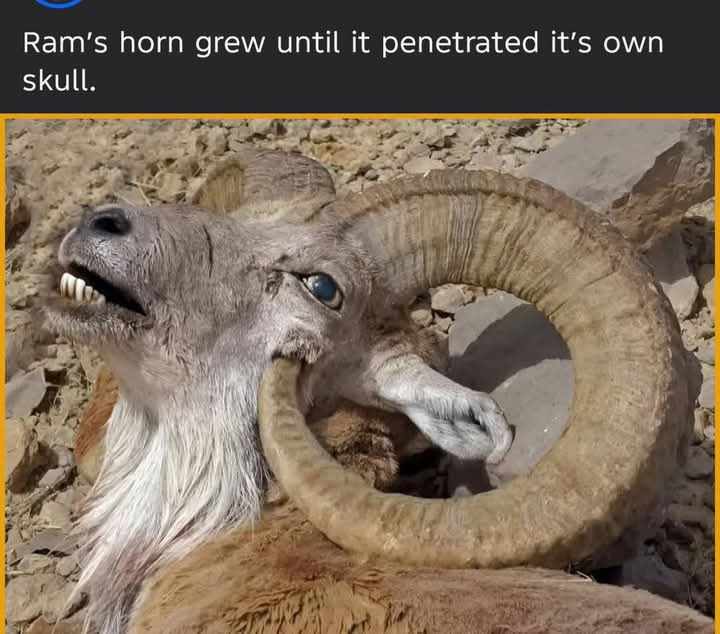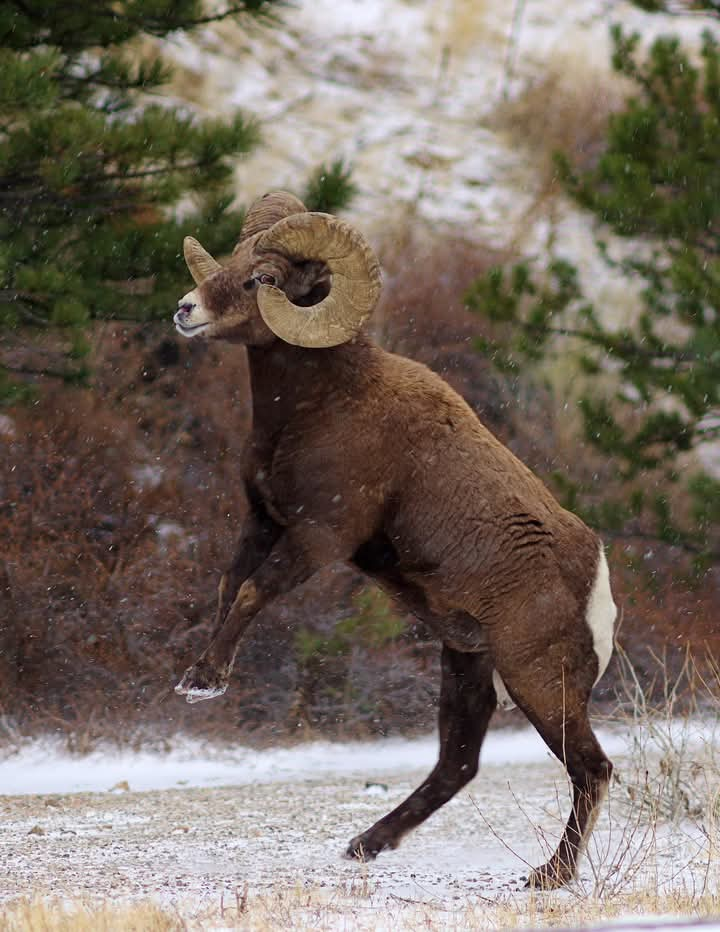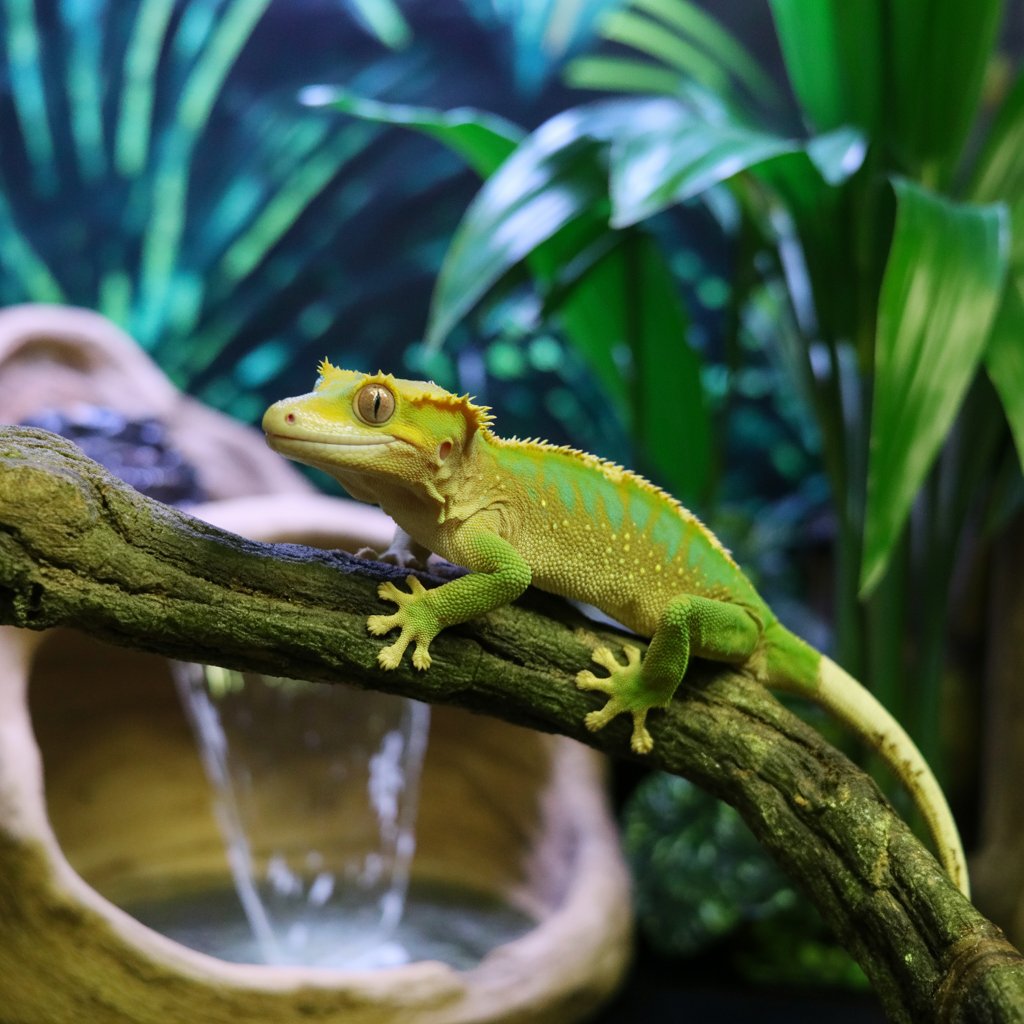When Nature’s Design Goes Too Far: The Tragic Case of Overgrown Ram Horns
In the vast tapestry of the natural world, few sights are as simultaneously fascinating and horrifying as witnessing nature’s own perfect design turn against itself. Recently, disturbing images have circulated across social media platforms showing a ram whose horn had grown so extensively and relentlessly that it had actually penetrated its own skull, creating a haunting and tragic reminder of what can happen when the delicate balance of natural processes is disrupted or allowed to proceed unchecked.
This phenomenon, while shocking and deeply unsettling to many people encountering it for the first time, is unfortunately not as rare as we might hope or expect. It represents a perfect storm of evolutionary biology meeting unfortunate environmental circumstances, resulting in what can only be described as one of nature’s most cruel and ironic twists of fate. The image serves as a stark reminder that even the most perfectly adapted biological mechanisms can become destructive when removed from their intended context or when the natural checks and balances that have evolved over millions of years are no longer present.
To truly understand how such a devastating and tragic situation can develop, we must first examine the unique and fascinating biology of ram horns, which differ significantly from the antlers found on deer and other cervids. Unlike antlers, which are shed completely and regrown annually in a remarkable cycle of regeneration, ram horns are permanent structures that grow continuously throughout the animal’s entire lifetime. They are composed primarily of keratin, the same protein that makes up human hair and fingernails, but arranged in a much denser and more durable configuration that can withstand tremendous impacts and forces.
The growth pattern of ram horns follows a precise spiral geometry that has been perfected through millions of years of evolution. Each horn emerges from a bony core attached to the skull and grows outward in a characteristic curve that varies slightly between different species and subspecies of wild sheep. This spiral pattern is not random but follows mathematical principles that maximize the horn’s effectiveness as both a weapon and a display of dominance while theoretically preventing the dangerous situation we see in cases of overgrowth.
The horns serve multiple critical functions in the natural behavior and survival of rams. During the breeding season, males engage in spectacular displays of strength and dominance through violent head-to-head collisions that can be heard from considerable distances. These confrontations are not merely aggressive displays but are essential components of the reproductive strategy that ensures only the strongest and most genetically fit males pass on their genes to the next generation. The massive, curved horns act as both weapons and shields during these encounters, allowing rams to deliver devastating blows while protecting their skulls from the reciprocal impacts.
In their natural habitat, this continuous horn growth rarely becomes problematic due to the presence of multiple natural mechanisms that act as a built-in maintenance system. Wild rams live in environments that naturally wear down their horns through various activities and behaviors that have evolved specifically to manage horn length and maintain optimal functionality. The frequent and intense head-to-head combat during rutting season naturally wears down the horn tips and edges, preventing them from becoming dangerously long or sharp.
Additionally, the rugged terrain that these animals call home provides constant opportunities for horn maintenance. As rams navigate rocky mountainsides, forage among stone outcroppings, and shelter against cliff faces, their horns are constantly rubbing against hard surfaces that act like natural grinding wheels. The abrasive action of granite, sandstone, and other geological formations gradually files down the horn material, maintaining an optimal length and shape that balances effectiveness with safety.
The animals also engage in various behavioral activities that contribute to horn maintenance. Rams frequently rub their horns against trees, rocks, and other environmental features, sometimes appearing to do so deliberately as a form of self-grooming. They may scrape their horns along the ground while feeding or use them to move obstacles, all of which contribute to the natural wearing process that keeps the horns at manageable lengths.
However, when these essential natural wearing mechanisms are absent, insufficient, or disrupted, the horns can grow beyond safe and functional limits, leading to the tragic outcomes we occasionally witness. This situation most commonly occurs in domestic sheep and rams that are kept in environments where they cannot engage in their natural behaviors or access the environmental features that would normally provide horn maintenance.
Animals in captivity face unique challenges that their wild counterparts do not encounter. Domestic rams kept in pastoral settings often live in environments with soft grass and dirt rather than the rocky terrain their ancestors navigated. The surfaces available to them may not provide adequate abrasion to wear down continuously growing horns. Furthermore, many domestic sheep have been selectively bred for docility, which may reduce their natural inclination to engage in the aggressive behaviors that would normally wear down their horns through combat.
Social isolation presents another significant risk factor for horn overgrowth. Rams that are kept alone or in small groups may not have adequate opportunities to engage in the dominance displays and fighting behaviors that naturally maintain horn length. In commercial sheep operations, rams are often separated from the flock except during breeding season, limiting their opportunities for the social interactions that would normally provide natural horn maintenance.
The consequences of unchecked horn growth extend far beyond the immediate physical damage and can create a cascade of health problems that ultimately threaten the animal’s survival. As the horn continues its relentless spiral growth pattern, following the same mathematical curve that served the animal well in its natural state, it may eventually begin to curve back toward the animal’s head in an increasingly dangerous trajectory.
The progression of this condition typically follows a predictable but tragic pattern. Initially, the growing horn may simply appear unusually large or prominent, which might be dismissed as a sign of a particularly robust or healthy animal. However, as growth continues unabated, the horn begins to curve more dramatically, eventually reaching a point where it interferes with the animal’s normal activities and behaviors.
As the horn continues to grow and curve, it may begin to restrict the animal’s field of vision, making it difficult for the ram to see potential threats or navigate its environment safely. The weight of the oversized horn can create balance problems and put stress on the neck muscles and vertebrae, leading to chronic pain and mobility issues that compound over time.
In the most severe cases, the sharp tip of the continuously growing horn eventually makes contact with the animal’s head or skull. Initially, this contact may cause only minor abrasions or pressure sores, but as the horn continues to grow with relentless determination, it can begin to create more serious wounds. The constant pressure and friction can lead to tissue death and the formation of open wounds that become entry points for bacterial infections.
When the horn actually penetrates the skull, as depicted in the disturbing images that have circulated recently, the situation becomes immediately life-threatening. The breach in the skull creates a direct pathway for bacteria and other pathogens to reach the brain and central nervous system. Even if infection is avoided, the physical trauma of having a foreign object continuously pressing against or penetrating brain tissue can cause severe neurological symptoms including seizures, behavioral changes, and progressive cognitive decline.
The animal’s ability to eat and drink normally becomes severely compromised as the horn interferes with normal head movement and jaw function. This leads to malnutrition and dehydration, which further weakens the animal’s immune system and reduces its ability to fight off infections or heal from the ongoing trauma. The combination of physical pain, neurological damage, and systemic health decline creates a downward spiral that inevitably leads to death if intervention is not provided.
The psychological impact on the animal should not be overlooked either. Rams are intelligent creatures with complex social behaviors and emotional responses. The chronic pain, restricted movement, and inability to engage in natural behaviors creates significant psychological stress that can manifest in various ways including depression, anxiety, and abnormal behaviors.
Professional veterinary intervention in cases of horn overgrowth requires significant expertise, specialized equipment, and careful planning to avoid causing additional trauma to an already compromised animal. The procedure is far more complex than simply cutting back the excess horn material, as ram horns contain blood vessels and nerve endings that extend varying distances from the skull depending on the individual animal’s anatomy and the stage of horn development.
Before any intervention can be attempted, veterinarians must conduct a thorough examination to assess the extent of the overgrowth and determine whether the condition has progressed to the point where treatment is still viable. This assessment includes evaluating the animal’s overall health status, checking for signs of infection or neurological damage, and using imaging techniques when available to understand the internal structure of the horn and its relationship to the skull and brain.
The actual horn trimming procedure requires the use of specialized cutting tools designed specifically for working with keratin structures. These tools must be sharp enough to cut cleanly through the dense horn material while allowing for precise control to avoid cutting too deeply into areas containing blood vessels or nerve tissue. The procedure is typically performed under sedation or general anesthesia to minimize stress and pain for the animal and to allow the veterinarian to work safely without the risk of sudden movements.
Determining how much horn material can be safely removed requires careful consideration of multiple factors. The veterinarian must identify the extent of the blood supply within the horn, often referred to as the “quick,” similar to the pink area visible in dog or cat claws. Cutting into this vascularized area can result in severe bleeding that may be difficult to control and can lead to infection or other complications.
The shape and angle of the cut are also critical considerations. The horn must be trimmed in a way that prevents sharp edges or points that could cause injury to the animal or handlers. The cut surface may need to be filed or smoothed to create a safe, rounded edge that will not cause problems as the horn continues to grow from the base.
Post-procedure care is essential for ensuring successful outcomes and preventing complications. The cut horn surface must be monitored for signs of infection, and antibiotics may be prescribed as a preventive measure. The animal requires ongoing observation to ensure that it is eating and drinking normally and showing no signs of neurological problems or other health issues related to the procedure.
Unfortunately, in cases where the horn has already penetrated the skull or caused significant neurological damage, the prognosis may be poor even with aggressive veterinary intervention. The damage to brain tissue cannot be reversed, and the risk of life-threatening infections may remain high even after the horn has been trimmed. In such cases, humane euthanasia may be the most compassionate option to prevent further suffering.
Prevention remains by far the most effective and humane approach to avoiding these tragic outcomes, and it requires a comprehensive understanding of ram behavior and biology combined with proactive management practices. Regular veterinary checkups should include careful assessment of horn growth, with measurements taken and recorded to track the rate of growth over time. This data allows veterinarians and animal caretakers to predict when intervention might be necessary and plan accordingly.
The frequency of horn trimming varies significantly between individual animals and depends on factors including genetics, age, diet, and environmental conditions. Some rams may require horn trimming every six months to a year, while others may need attention more or less frequently. Establishing a regular schedule based on the individual animal’s growth pattern is essential for preventing overgrowth situations.
Environmental enrichment can play a significant role in promoting natural horn wearing behaviors even in domestic settings. Providing rams with access to rocks, concrete surfaces, or specially designed rubbing posts can encourage them to engage in the natural behaviors that help maintain horn length. Some livestock operations have successfully used artificial surfaces designed to mimic the abrasive qualities of natural rock formations.
Social housing arrangements should also be carefully considered to promote natural behaviors while maintaining safety for all animals. Allowing rams to interact with each other in controlled settings can provide opportunities for the dominance displays and mild aggressive interactions that contribute to natural horn wearing. However, this must be balanced against the risk of injury from more serious fights, particularly among animals that have not been raised together.
Dietary factors may also influence horn growth rates, though research in this area is limited. Some animal nutritionists suggest that certain minerals and vitamins may affect the rate of keratin production, potentially influencing horn growth. Ensuring proper nutrition with appropriate levels of protein, minerals, and vitamins may help maintain healthy horn growth patterns, though this should not be relied upon as the sole method of preventing overgrowth.
The breeding and genetic aspects of horn growth present additional considerations for livestock producers and conservationists. Some bloodlines may be genetically predisposed to more rapid or extensive horn growth, while others may naturally produce more manageable horn sizes. Selective breeding practices that favor animals with moderate horn growth characteristics could help reduce the incidence of overgrowth problems in domestic populations.
However, this approach must be balanced against other important genetic considerations including disease resistance, productivity traits, and the preservation of genetic diversity within domestic sheep populations. The removal of genes associated with large horn development could have unintended consequences for other aspects of the animal’s biology and adaptation.
Educational outreach to livestock owners, veterinarians, and the general public plays a crucial role in preventing these tragic situations. Many people who keep sheep or rams as pets, livestock, or for land management purposes may not be aware of the need for regular horn maintenance. The assumption that animals will naturally manage their own horn growth can prove fatal, as we have seen in the disturbing cases that have come to public attention.
Veterinary schools and continuing education programs for practicing veterinarians should include training on horn trimming techniques and the recognition of horn overgrowth problems. Not all veterinarians have extensive experience with sheep and goats, and those practicing in areas where these animals are less common may not encounter horn problems frequently enough to maintain proficiency in the necessary procedures.
The economic aspects of prevention versus treatment also deserve consideration. Regular preventive horn trimming is relatively inexpensive and can typically be performed during routine veterinary visits. In contrast, emergency treatment for severe overgrowth cases requires specialized expertise, emergency veterinary care, and often results in poor outcomes despite significant expense.
From an animal welfare perspective, the prevention of horn overgrowth represents a fundamental responsibility of animal ownership. The domestication of sheep and rams has removed these animals from the natural environments and behaviors that would normally prevent such problems. In accepting the benefits of domestic animals, humans also accept the obligation to provide care that compensates for the loss of natural regulatory mechanisms.
The broader implications of horn overgrowth cases extend beyond the immediate animal welfare concerns to touch on questions about the relationship between humans and domestic animals. These cases highlight the complexity of removing animals from their natural environments and the ongoing responsibility required to ensure their wellbeing in artificial settings.
Wildlife conservation efforts also intersect with domestic animal management in important ways. Understanding the natural behaviors and environmental factors that prevent horn overgrowth in wild populations can inform best practices for managing domestic animals. Conversely, problems observed in domestic populations can provide insights into potential vulnerabilities that might affect wild populations under changing environmental conditions.
Climate change and habitat modification could potentially alter the environmental factors that naturally regulate horn growth in wild sheep populations. Changes in terrain, vegetation, or social structures within wild herds could theoretically create conditions similar to those that lead to overgrowth in domestic settings. Monitoring wild populations for unusual horn development patterns could provide early warning signs of environmental problems.
The psychological impact of witnessing or learning about cases of severe horn overgrowth should not be underestimated. Images of animals suffering from this condition can be deeply disturbing and may contribute to public distrust of animal agriculture or pet ownership practices. This emotional response, while understandable and often justified, can also complicate efforts to address the problem through education and improved management practices.
Effective communication about horn overgrowth requires balancing the need to raise awareness about the problem with sensitivity to the emotional impact of disturbing images and descriptions. Educational materials should focus on prevention and early intervention rather than dwelling on the most severe cases, while still conveying the seriousness of the potential consequences of neglect.
The role of social media in spreading awareness about animal welfare issues like horn overgrowth presents both opportunities and challenges. While platforms like Facebook, Instagram, and Twitter can rapidly disseminate information about animal care practices to large audiences, they can also spread misinformation or create emotional reactions that may not lead to constructive outcomes.
Veterinary professionals and animal welfare organizations have a responsibility to provide accurate, science-based information about horn management and to counter misinformation that might circulate on social media platforms. This requires ongoing engagement with online communities and a commitment to providing reliable resources that people can access when they need information about caring for their animals.
The story of the ram whose horn grew into its skull ultimately serves as a powerful reminder of the complex responsibilities involved in animal care and the importance of understanding the biological needs of the species we choose to keep. It illustrates how seemingly small oversights or gaps in knowledge can lead to tragic outcomes and emphasizes the need for ongoing education and vigilance in animal husbandry practices.
Moving forward, the prevention of horn overgrowth cases will require coordinated efforts from multiple stakeholders including veterinarians, animal owners, educational institutions, and animal welfare organizations. By working together to raise awareness, improve education, and establish best practices for horn management, we can ensure that fewer animals suffer from this preventable condition.
The image of a ram with its horn grown into its skull should serve not just as a shocking example of what can go wrong, but as a catalyst for positive change in how we understand and care for these remarkable animals. Through proper education, prevention, and care, we can honor our responsibility as stewards of domestic animals while ensuring that their natural biological processes serve them as evolutionary intended rather than becoming sources of suffering and tragedy.






